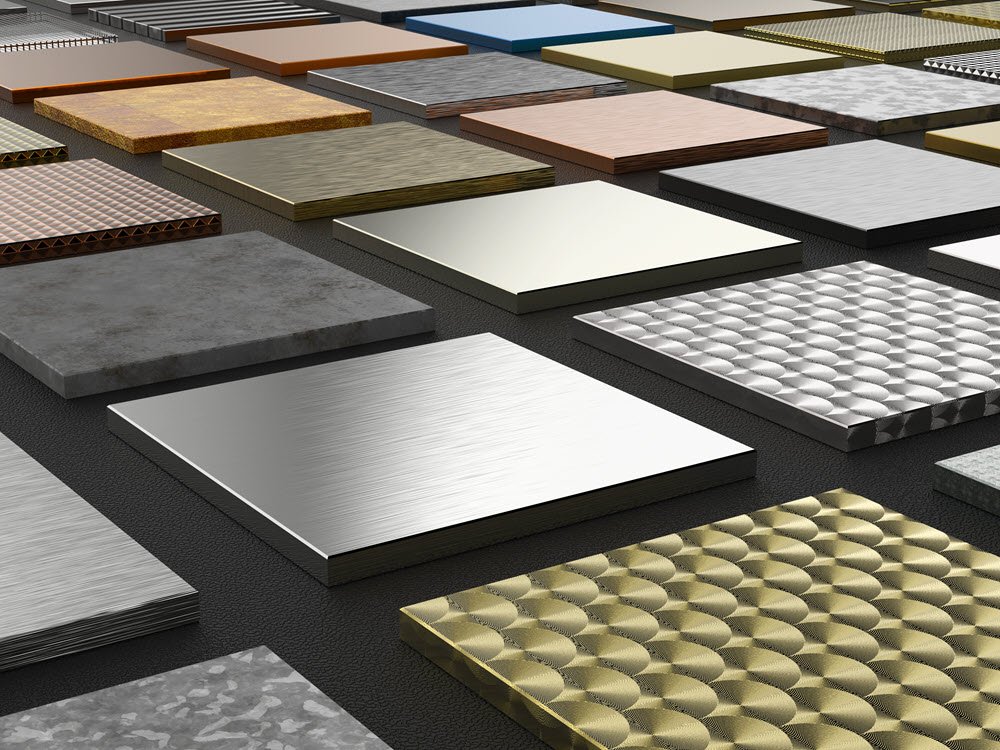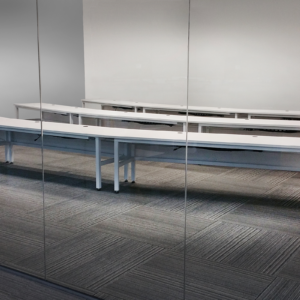Folding glass screens? Metallic foams? Invisibility cloaks? Here’s what we can expect to see in future products as manufacturers begin to incorporate materials from the future into their full-scale manufacturing processes.
Advanced Structural Materials – Which is Better: Steel, Aluminum, or Carbon Fiber?
When it comes to structural applications, steel materials offer a unique value proposition, based on a combination of these five characteristics that make it hard to beat:
- high-strength
- toughness and ductility
- relatively low cost
- high availability
- ready recyclability

Yet, in automotive structural applications, where lower weight can increase fuel economy, steel is increasingly being challenged by aluminum and carbon fiber materials. Ford began building the current generation of its top-selling F150 pickup trucks out of aluminum to conserve weight. Despite television advertising campaigns by General Motors bashing Ford’s choice (they literally bash the pickup beds by dropping tool boxes on them), Ford has maintained the confidence of its loyal customer base, who look forward to another advantage of aluminum: less body corrosion due to road salt.
Meanwhile, GM has taken a new tack by investing in the manufacturing of its pickup truck beds out of carbon fiber material. Why the change? For vehicle manufacturers, carbon fiber offers a combination of extremely low weight and toughness. Product design engineers can also build in design features during the carbon fiber mold up process, for example, the carbon fiber bodies of BMW i3 electric cars have hollow internal channels to accommodate wiring harnesses – no additional fasteners are required.
Which material is best? For industrial furniture, 99% of Formaspace customers choose steel frames. But the choice of materials depends on the application. For stamped panels, aluminum is trickier to form and to weld than steel, while carbon fiber can be formed into a wide variety of complex shapes. From a sustainability perspective, steel and aluminum are the most easily recyclable. Manufacturers also need to be careful to avoid waste during carbon fiber production. (The BMW i3 uses excess raw carbon fiber scraps to create the roof structure.)
Tooling costs can be a decisive consideration. According to cost engineering analyst Sandy Munro (whose company Munro Associates has torn apart more than 200 vehicles), the tooling costs for a monocoque (unibody) steel body vehicle can cost upwards of $450 million, which necessitates high production (in the millions). In contrast, the tooling for a carbon fiber vehicle could be as low as $112 million, making it economically feasible to produce at much lower annual volumes, e.g. in the tens of thousands.
Let’s turn to aerospace applications for a moment. Here, the paramount design consideration is weight reduction, which is why aluminum structures have long dominated aircraft manufacturing. Boeing’s 787 Dreamliner program changed the equation by introducing a wide-bodied jetliner with a composite carbon fiber fuselage, wings, and empennage (tail structure). Despite the much-delayed development process, the 787 (and its carbon fiber bodied competitor, the Airbus A350) has had a good track record to date. However, the first generation 787 800s were heavier than expected – due to unforeseen difficulties bonding the wings to the fuselage – which necessitated the addition of a large number of heavy and expensive titanium fasteners.
If you have flown on a 787 Dreamliner, you may have noticed the extreme flexibility of its wings (it can be a bit disconcerting for the uninitiated). Sailboat designers are also taking advantage of carbon fiber’s ability to flex without breaking: some new boat designs now use carbon fiber masts, which eliminate the need for much of the traditional rigging (such as stay lines) that traditional wood or aluminum masts need for support during heavy wind gusts.
Meanwhile, aluminum manufacturers have not stood idly by. New Aluminum-Lithium (Al-Li) alloys not only weigh less than traditional aircraft grade aluminum, but they also appear to offer increased stiffness, better corrosion resistance, improved fatigue strength, as well as improved resistance to crack propagation. Engineers working on the new Airbus A220 series narrow-body aircraft (originally developed by Bombardier) claim that using Al-Li alloys have allowed them to remove tons of weight. Boeing is also expected to use this new material in its next generation 777 wide-body aircraft, the 777-X.
Artificial intelligence powered CAD tools are also making a difference. Using machine learning, these design systems can look at literally millions of design alternatives to create structures that are stronger and weigh less – despite the fact they may look entirely improbable, as in this example of a bulkhead panel for the Airbus A320 family of aircraft.

Another important consideration for product design engineers choosing between materials is whether they can be used in additive manufacturing, e.g. 3D printing. The aerospace divisions of GE, Honeywell, and United Technologies are making big investments in additive manufacturing in order to simplify production. In one case, GE was able to “print” a single heat exchanger part as one unit, which previously required welding together 300 individual pieces.
Turning to building design, steel and concrete materials remain dominant in the commercial building industry. However, wood materials, once generally limited to residential or low-rise commercial projects, are starting to make inroads. For example, in Canada, which is a leading supplier of wood products, the federal government has announced a new program called The Green Construction Through Wood initiative, which provides incentives for buildings higher than 10 stories made of wood products. The leading example of this new renaissance in wood construction is the Brock Student Residence at the University of British Columbia, which, at 18 stories, is the tallest contemporary wooden building in the world. Advocates of wood construction point to the strength of cross-laminated timber (CLT) as well as the reduced carbon footprint of wood buildings.

But we shouldn’t give up on concrete structures just yet. New innovations are making concrete more competitive. For example, researchers at the Department of Architecture at ETH Zurich in Switzerland have developed concrete floor elements that are 70% lighter than conventional concrete floors and do not require steel reinforcement. Meanwhile, other research teams are investigating the possibility of reinforcing concrete with carbon fiber to create a new material, dubbed carbon concrete or textile concrete. Unlike steel reinforcements, which can rust and weaken the structure, adding carbon to the concrete can increase its loadbearing capacity by five or six times compared to traditional steel reinforced concrete, while reducing weight by 75%.
Exotic High Strength Materials
Diamonds, long associated with wedding rings and high-fashion, offer tantalizing advantages for manufacturing. Whether natural or man-made, diamonds are incredibly strong, yet light and resistant to heat, making them an ideal choice for the cutting edges of drill bits and other machine tools.
What if you could use a 3D printer to create diamond structures? Could you print out diamond turbine blades for a jet aircraft engine? Lockheed Martin filed the patent two years ago for a diamond-based 3D printer, although we’re unsure if or when they plan to make this a commercially available technology. Meanwhile, researchers in Australia at the ARC Centre of Excellence for Electromaterials Science (ACES) have published a paper on the possibility of printing microdiamonds within an ABS plastic substrate. Microdiamonds and their smaller companion, nanodiamonds (aggregated diamond nanorods, or ADNRs for short), are as hard as normal diamonds but offer superior wear resistance.
Material scientists have been able to manipulate the crystal structure of metals to create a new class of materials, known as Amorphous Metals (or metallic glasses). By creating disordered atomic structures, these new materials can withstand direct impact more effectively, making them of great interest for military use, such as for armor piercing ammunition. Amorphous metals are also more efficient at transmitting electricity (40% more efficient) than conventional metals.
Adhesives with extraordinary properties are also on the short-term horizon line. Researchers at the University of Oxford in the UK have created a new kind of superglue that bonds materials at the molecular level. They extracted a single protein from the bacterium Streptococcus pyogenes (commonly known as the dangerous “flesh-eating” bacteria). The resulting glue uses covalent bonds to form an incredibly strong bond with the proteins of another surface. Meanwhile, scientists in Australia have developed a plant-based gel that stops bleeding quicker than any other method available. It’s made from a natural polymer found in algae.
The Japanese company Spiber has teamed up with Goldwin to create a high-performance prototype spider silk ski jacket.
If you are a fan of Spiderman, you know that spider silk is incredibly strong and flexible. The Japanese company Spiber has identified the gene responsible for producing the key protein in silk, fibroin, and has developed bioengineered bacteria that allows the company to grow artificial spider silk in mass production quantities. A single gram of fibroin can produce 9 km of spider silk!
Ultra Light Weight Materials
Aerogel has sometimes been described as frozen smoke: it’s 99.8% empty space. Made by a process of supercritical drying of liquid gels, such as alumina, chromia, tin oxide, or carbon, this material (available under the brand name Airloy) is 100 times lighter than water, yet it can carry 20,000 times its own weight. It’s also an incredible insulation material: you can stack some crayons on top of a thin layer of aerogel and use a blowtorch underneath without melting the crayons. This super insulating property could protect military personnel from a flamethrower or keep astronauts warm while traveling in space.

Aerogel is rigid. What if you wanted a highly compressible lightweight metal material? Boeing has introduced such material, which they call a Microlattice. Like aerogel, it’s incredibly light. (Boeing demonstrates this by placing a piece of microlattice on top of a dandelion, which does not compress the delicate seedpods.) Boeing engineers expect to use this weight saving microlattice material in future aircraft structure designs.
Boeing’s Microlattice material is incredibly lightweight and highly compressible, with great recovery properties.
There are two more classes of weight saving materials on the horizon: syntactic foam and metal foam. Syntactic foam is a synthetic composite material embedded with hollow spheres while the metal foam is produced by adding gases during the material production (to create either a closed cell or open cell foam structures within the material). Both of these materials have a great strength to weight ratio, while providing superior impact resistance, making them an ideal choice for safety equipment in a range of products, from crash absorbent zones in vehicles to bicycle helmets.
Energy Transfer Management
Traditional photovoltaic solar energy panels are rigid and flat. While that makes them suitable for placement on the roof of the building, they aren’t conducive for fitting around curved surfaces, such as the roof of a car. That’s why material scientists are looking at solar cells made with Perovskites, which are not only potentially cheaper to build than traditional solar cells, they aren’t limited to rigid flat shapes, allowing them to be fitted to a greater number of devices.
Excess waste heat created either by machines or conventional power generation is another potential source of energy. Google’s parent company, Alphabet, is investing in a thermoelectric generator that can capture heat from exhaust pipes and turn it back into useful electricity, using a material called Tetrahedrite. Engineers at Alphabet Energy claim they can recover energy at between 5 to 10% efficiency using this method. Another material, Skutterudite, shows promise for extracting energy from heated surfaces as well.
Discovery of Metallic Hydrogen at Harvard University
Scientists are also looking for another holy grail, the promise of room temperature superconductivity. While superconductor materials exist at ultra-low temperatures, the cost and complexity make them impractical to use for power transmission. However, Harvard University researchers recently announced the creation of solid metallic hydrogen that has the potential (pardon the physics pun) to create room temperature superconductor wires, which would eliminate millions and millions of dollars’ worth of energy lost to inefficiencies in metal-based transmission lines used in conventional electric power grids.
Futuristic Glass Applications
Apple and Samsung fanboys (and fangirls) are understandably excited about the leaked product information about future smartphone devices that feature bendable glass surfaces.
Those aren’t the only exciting new developments in glass manufacturing on the horizon. We talked about amorphous metal – a form of metallic glass – earlier. Now we like to talk about transparent metals, including transparent aluminum, aluminum oxynitride, which is available from the Surmet Corporation under the brand ALON. It’s reportedly 3 times harder than steel and 4 times harder than fused silica glass. Applications for this new material include bulletproof glass, infrared domes, and cockpit windows in aircraft and spacecraft, as well as use under high-stress applications, such as tall skyscrapers.
One of Surmet’s markets for transparent aluminum is as a replacement for bulletproof glass, as shown in this dramatic test footage (video has no sound)
Futuristic Textiles
Volkswagen AG, whose street cred as an environmentally-friendly car company was severely damaged by the diesel gate scandal, has introduced a new full-size SUV with a unique upholstery material, a synthetic leather made from apple-juice waste. Dubbed AppleSkin, the new material offers a vegan-approved alternative to traditional cow leather.
Expect to see more innovation in textile materials in the near future. Tomorrow’s “smart clothing” fashion designs (from companies such as Lumigram) may include so-called electronic textiles that can project images, such as videos, Blade-Runner style from the cloth surface. Future textile designs may also be able to absorb energy (see the previous section) from excess heat or movement to help power the devices embedded in the clothing.
Biomimicry, the concept of applying design concepts from living organisms to synthetic, man-made products, is the inspiration for Sharklet, a plastic sheet product that’s designed to prevent the growth of bacteria, an especially important consideration in a world increasingly threatened by bacterial superbugs. The material, which is used in hospitals and other locations where bacterial growth can cause infections, is inspired by the unique micro-pattern found in shark skin. NASA is interested in using the material to prevent bacterial formation in their space vehicles.
Are Harry Potter-style “Invisibility cloaks” possible or not possible? The answer: possibly possible. Researchers are looking at so-called metamaterials, which have unique structural properties that can manipulate the passage of light around them. (Shimmering mother-of-pearl is an example of a metamaterial found in nature.) By carefully manipulating the surface of metamaterials, scientists are hoping to create built-in “superlenses” that could render perfect holograms, or make the surface appear to disappear entirely by bending light rays around the object to reveal the background instead.
Reducing Material Use, Such as Plastics
The negative effects that plastics are having on our environment has become more widely understood. Devastating images of nature in peril, from the emergence of the Great Pacific Trash Patch in the middle of the Pacific Ocean to images of dying birds, whales, and other marine life literally choking to death on plastic they mistake for food is heartbreaking. And the problem is not limited to our oceans, recent research shows that natural winds are carrying microplastic pollution to all corners of the earth.
Biomimicry may provide the answer. We need to create and use plastic substitutes that don’t cause environmental harm. Here are a few examples:
- Ecovative Designs has created a substitute for Styrofoam used in packing materials. Their product is made of agricultural crop waste, including plant stalks, rice, and wheat husks, all bonded together with a mushroom-based glue.
- Researchers at the Wyss Institute and Harvard University are creating bio-plastics that are similar to natural insect cuticles, such as those found in rigid exoskeletons of flies and grasshoppers. These offer greater strength and flexibility than traditional plastics and are biodegradable.
- Israeli scientists are experimenting with using human cells to create a heart pump. Rather than using plastics, this approach uses a 3D printer to print human cells to create working heart passages and valves.
Finally, eliminating plastic parts by designing them out of a product may be the most environmentally-friendly approach of all. Sandy Munro (mentioned earlier) has advance word that Tesla plans to reduce the amount of wire in their Model 3 car from 1.8 kilometers to less than 100 meters of wire. Munro believes this will be reserved for electric motive power use only, and that wireless communication will be used in lieu of a traditional wiring harness data bus.
Turn to Formaspace for Efficient Manufacturing Solutions
If you can imagine it, we can build it.
We’re here to help you make your manufacturing processes more efficient and profitable, thanks to our modern, industrial furniture solutions.
Talk to our dedicated team of Formaspace Design Consultants to find out how we can work together.
Find out why leading companies, including SpaceX, Oculus, Toyota, Busch, Apple, Google, Twitter, and Capital One choose Formaspace.
Make the connection. Contact us today.












